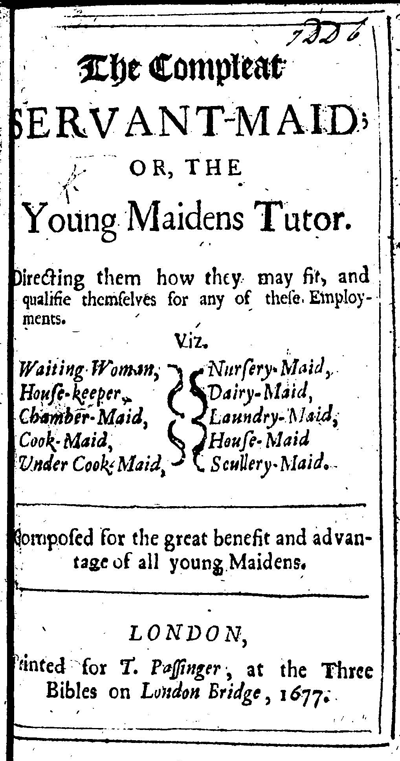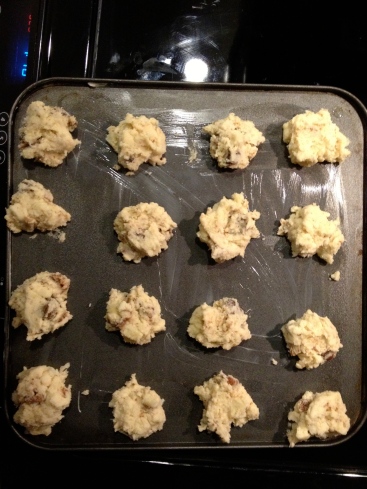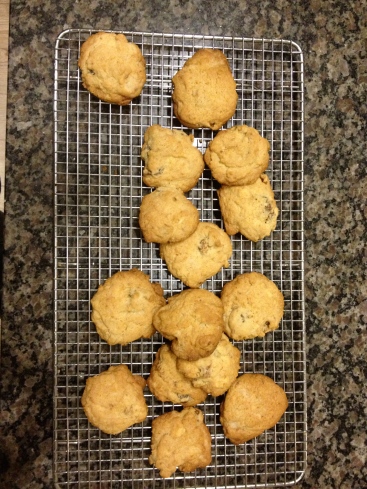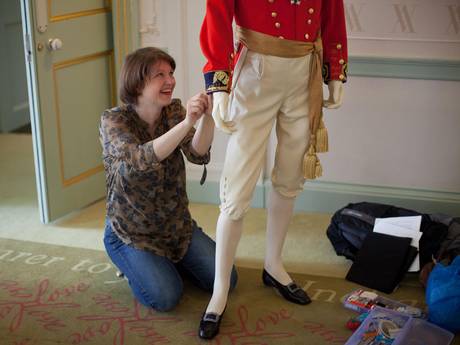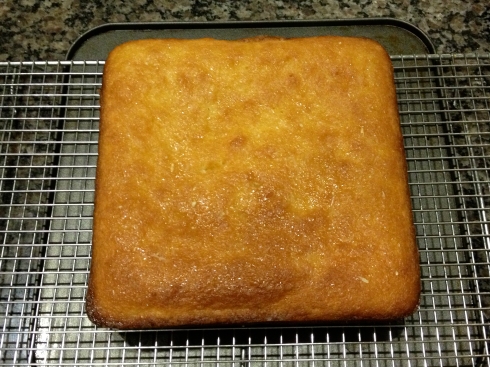Title page from the Compleat Servant-Maid by Hannah Woolley (1677) image from Design your life
Would you turn to Nigella for tips on household cleaning? Or how about consulting Jamie about how to treat a common cold, or reduce a swelling? Our modern separation of food from medicine from cleaning products is one which would probably have seemed strange to our ancestors who would have expected to produce a range of all three at home. Many books which we might now term cookery books were so much more than this; offering the housewife or housekeeper advice on a diversity of household management topics, including the making of herbal remedies and preparations for cleaning clothes, furniture and textiles. A sample of some of their titles not only underlines this point but also demonstrates the value placed on the skills of good household management:
- Domestic management, or the art of conducting a family; with instructions to servants in general. Addressed to young housekeepers, c.1800
- The Housekeepers Manual of Cookery and Domestic Economy, 1859
- Housekeeping A Guide to Domestic Management by Mrs Humphry (Madge of Truth) 1893
As Mrs Humphry warned readers in her introduction ‘Good housekeepers are comparatively rare. To keep house efficiently needs a combination of qualities which Nature seems niggardly in doling out.’ Books of domestic management therefore were needed to guide women in the arts of housekeeping, so that they could be an asset to their husband/employer.
Medicines and cleaning products, just like cakes, soups and preserves, would all be prepared using what was known as a ‘recipe’ or more commonly before the 19th century a ‘receipt’. The Oxford English Dictionary etymology shows how the word developed from the Latin verb recipere, to receive, which in its 2nd singular imperative, was written by physicians at the top of their prescriptions. The earliest use the OED cites for recipe/receipt being used to describe the ingredients and methods for making an edible preparation is 1595 when the Widowes Treasure talks of ‘A notable receite to make Ipocras.’ And in his 1755 dictionary Dr Johnson defines ‘receipt’ (derived from recipe) as a ‘prescription of ingredients for any composition’.
It’s in this broad context of household management that we find in the lengthily titled The Housewife, being a most useful assistant in all domestic concerns, whether in a town or country situation (1785?) by Laetitia Montague, (Sometime companion to a lady in one of the first families in the Kingdom) the fascinating ‘recipe’ For an earwig gotten into the ear;
‘Get rue, and stamp it in a mortar; then strain off the juice, and put it into the ear; then lie down to rest on the contrary ear, and when you awake the juice will come out and the earwig will be dead.
The juices of wormwood, southernwood, and rue equal quantities, put into the ear will also kill any vermin that is got into it.’
While Mrs Humphry (1893) advises that To Dislodge a Fish Bone from the Throat;
‘Take an emetic compounded of four grains of tartar emetic dissolved in a tumberful of warm water. Immediately afterwards, drink down the white of four eggs. This will be efficacious in causing sickness and the bone will probably come away with it’
No-one offered me a medicinal receipt in my Kensington book of Historic Royal Recipes but the contribution from Sebastian was a receipt for the cleaning of household linen. Sebastian is the softly spoken Deputy Chief Curator for Historic Royal Palaces, full of wise and witty advice and a fount of knowledge on a whole host of subjects including the furniture of royal palaces (look out for his Secrets of the Royal Bedchamber opening at Hampton Court on 27 March!) He was also responsible for handling the return of one of my favourite portraits to Hampton Court, the wonderful Van Dyck painting of the young Princess Mary (eldest daughter of Charles I) which is believed to have hung in the palace while Charles was living there under house arrest during the English Civil War.
Now, I’m more than prepared to try most of the recipes in my book but this one I have not verified by practical experimentation (not only did I not want to mess about with the necessary ingredients, I didn’t have any ink stained clothing to practise on). You’ll be even more delighted to hear that this means that there is no photographic evidence to accompany it. Here is Sebastian’s recipe (courtesy of Hannah Woolley) in full:
To get Spots of Ink out of Linne Cloth
‘Before that you suffer it to be washed, lay it all night in urine as if you were washing it in water; then lay it in more urine another night and then rub it again, and so do till you find they be quite out.’
Hannah Woolley, The Compleat Servant-Maid (1677)
It’s ironic in a way how important urine has been in the preparation of cloth and the care of clothes, given how much time is spent trying to remove human waste from laundry. Fulling the process of cleansing newly made cloth to remove impurities and make it thicker used urine (or wash as it was known) to soften and whiten the cloth. The medieval toilet, the garderobe, gained its name because clothing was hung there so that the ammonia rich environment would kill the fleas and other insects. As Hannah Woolley’s spot remover demonstrates urine continued to be important in the care of clothes and urine from chamber pots and privies was collected for the purpose.
Of course a fabric cleaning recipe is a very appropriate choice for a curator of historic dress (this was not a technique we ever used to try and get rid of ink spots at Kensington) and despite my reluctance to begin testing this within the confines of our modern apartment I am fascinated by the history of keeping clothes clean, not least because a brief trawl through the history of clothes laundering and cleaning quickly reminds you how pain free modern appliances and commercial dry cleaning have made the business of keeping clothes clean. No longer the messy, arduous and sometimes highly dangerous business of preparing your own soap and urine stain removers, poking clothes through mangles and lifting heavy piles of soaked washing from boiling coppers. When you next lift your clothes from your user-friendly washing machine or treat the coffee spill on your shirt with a neatly packaged, pre-prepared stain remover you can be glad that you don’t have to think about setting your urine aside for future use! Thanks for the recipe Sebastian. See below for a few more clothes cleaning recipes and links to some of my favourite historic laundry pictures.
Recipes
Housekeeping A Guide to Domestic Management by Mrs Humphry (Madge of Truth,) 1893
‘To take out a wax candle or sperm stains Lay a piece of blotting-paper on the stain. Put a live coal from the fire into a kitchen spoon, hold the spoon on the blotting paper. The heat will cause the latter to absorb the grease’
The New England Cook Book, or Young Housekeeper’s Guide, n.d
36. To clean Silk Stockings.
Wash the stockings in mildly warm hard soap suds, rinse them in soap suds and if you wish to have them of a flesh color, put in a little rose, pink or cochineal powder; if you prefer a bluish cast, put in a little indigo. Hang them up to dry without wringing, when nearly dry, iron them on the right side, till perfectly so. If you wish silks of any kind to have a gloss on them, never rinse them without soap in the water.
39. To clean Light Kid Gloves.
Magnesia, moist bread and India Rubber, are all of them good to clean light kid gloves, if rubbed on thoroughly.
The Book of Household Management by Mrs. Isabella Beeton, 1861
Silks, when washed, should be dried in the shade, on a linen-horse, taking care that they are kept smooth and unwrinkled. If black or blue, they will be improved if laid again on the table, when dry, and sponged with gin, or whiskey, or other white spirit.
The Easiest Way In Housekeeping And Cooking. Adapted To Domestic Use Or Study In Classes by Helen Campbell, 1903
‘If any fruit-stains are on napkins or table-cloths, lay the stained part over a bowl, and pour on boiling water till they disappear. Ink can be taken out if the spot is washed while fresh, in cold water, or milk and water; and a little salt will help in taking out wine-stains. Machine-oil must have a little lard or butter rubbed on the spot, which is then to be washed in warm suds. Never rub soap directly on any stain, as it sets it. For iron-rust, spread the garment in the sun, and cover the spot with salt; then squeeze on lemon-juice enough to wet it. This is much safer and quite as sure as the acids sold for this purpose. In bright sunshine the spot will disappear in a few hours.’
Pictures
The Fortress of Konigstein: Courtyard with the Magdalenenburg by Bernardo Bellotto, 1756-8, which shows on the right hand side women putting the linen out on the grass to dry and bleach in the sun. (Manchester City Art Galleries)
Manual Labour: An Interior with Three Figures Folding Laundry by Wyn Casbolt, 1943 (UCL Art Gallery)
A Lady’s Maid Soaping Linen by Henry Morland, c.1765-82 (Tate Galleries)
Restored Cathedral with Washing on the Drying Green by H Eadie, 1907 (Dunblane Museum)
Y Lein Ddillad (The Washing Line) by Helen Steinthal, 1964-1966 (Bangor University)
